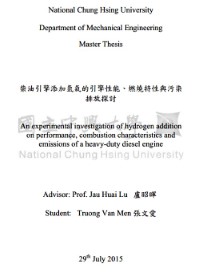|
|
|
Tác giả: Trương Văn Mến. Prof. Jau Huai Lu (người hướng dẫn khoa học). |
|
National Chung Hsing University. Năm: 2015. |
|
Mô tả: 94Tr. Kích thước: 30cm. Số định danh: |
|
Abstract This research was conducted to investigate the effects of H2 addition, engine load, and diesel fuel flow rate on the brake thermal efficiency (BTE), incylinder pressure, heat release rate, exhaust temperature and exhaust emissions of Oxides of Nitrogen (NOx), Carbon Monoxide (CO), unburned Hydrocarbon (HC), Carbon Dioxide (CO2) and smoke. The engine load was varied from 25 to 100% with H2 concentration in the intake mixture (H2/(H2+Air), vol.) varied from 3 to 7% at engine speed 1650 RPM. The combustion analysis illustrated that the effect of the addition of H2 on combustion process depended on the load and the amount of H2 added. The addition of H2 at 25% load substantially deteriorated the premixed combustion but slightly enhanced and elongated the diffusion combustion. Conversely, the addition of H2 at 70% and 100% loads substantially increased the peak cylinder pressure, rate of pressure rise and peak heat release rate with slightly advance of phasing. In addition, adding hydrogen has small effect on the cyclic variation of combustion of H2-diesel mixtures in a diesel engine. For emissions, the addition of H2 shows that there was a slight reduction of the emissions of CO except for 100% engine load. Furthermore, the better combustion of hydrogen fuel and the absence of carbon atom in hydrogen molecule are the reasons leading to the decreases of CO2 emission and opacity. Especially, at 75% load, the change of CO2 emission was significant and the largest reduction of CO2 was obtained 32.3% with 7% H2 addition compared to neat diesel fuel. Although there was not different in HC emissions with and without H2 supplement they tended to decrease in H2-diesel dual fuel operation. In addition, the good effect H2 addition on PM was also found at 50% and 75% engine loads. The improvement to the BTE has been one of the main objectives of this engine research. Unfortunately, the addition of a relatively large amount of H2 (3- 7%) at different engine loads did not improve the BTE of the engine. At 25% load, the brake thermal efficiency reduced about 30% at 7% H2 enrichment while the values were 17.5%, 13.1% and 10.6% when engine loads were 50%, 75% and 100%, respectively, with the same amount of H2 addition. It is found that unburned H2 was main reason for reduction of BTE, obviously at low and medium loads. The measured exhaust temperature increased gradually at all tested engine loads. In particular, the exhaust temperature at 7% H2 added rose 7.4%, 10.4%, 11% and 12.3% when engine run at 25%, 50%, 75% and 100% of load, respectively. Besides, the higher temperature combustion caused increase of the NOx emissions for all cases of H2 addition. |
